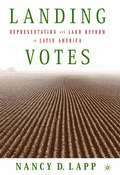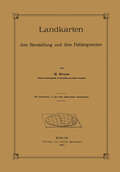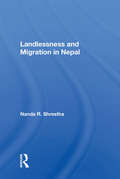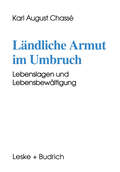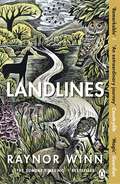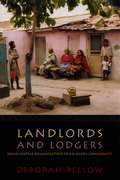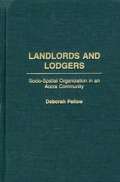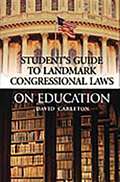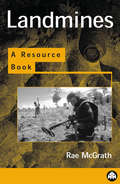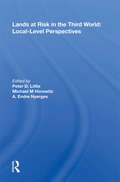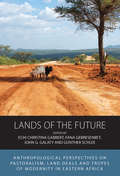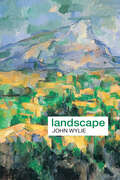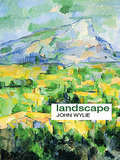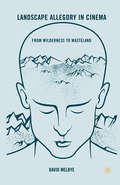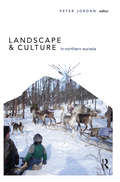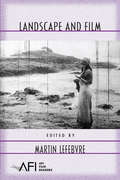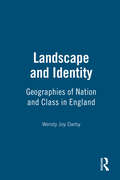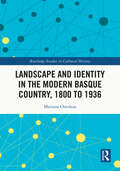- Table View
- List View
Landing Votes: Representation and Land Reform in Latin America
by N. LappLanding Votes explores the conditions under which democratic Latin American governments address persistent political and economic inequities. The book points out a surprising 'coincidence': nearly every extension of suffrage to the rural poor occurred at the same time as land reform. Politicians did not merely react to peasants' demands; rather, they sought political power by extending the right to vote while redistributing land. The book concludes that party institutionalization enhanced the prospects for reforms by holding politicians accountable. More significant reforms occurred which benefited more of the rural poor where institutionalized parties competed for their votes.
Landlessness And Migration In Nepal
by Nanda R. ShresthaThis book aims to describe, understand, and explain the social, political, and geographic consequences of frontier migration, focusing on landlessness, nearlandlessness, and spontaneous settlement among hill migrants in the Tarai of Nepal.
Landlessness And Migration In Nepal
by Nanda R. ShresthaThis book aims to describe, understand, and explain the social, political, and geographic consequences of frontier migration, focusing on landlessness, nearlandlessness, and spontaneous settlement among hill migrants in the Tarai of Nepal.
Ländliche Armut im Umbruch: Lebenslagen und Lebensbewältigung
by Karl August ChasséDer Leser hat ein umfangreiches Buch vor sich. Was erwartet ihn? Der Text ist trotz reflektierender Abschnitte kein theoretisches Werk. Es ist in erster Linie der Bericht über eine empirische Studie, die natürlich ihre theoretischen Voraussetzungen hat und diese auch offenlegt, doch die Ergebnisse laden zum Disput ein. Zentrale Begriffe der Armutstheorie, wie Lebenslagen und soziale Ungleichheit, benachteiligte und arme Lebenslagen, die Differentialität von Lebenslagen, die subjektive Gestaltung von Lebenslagen und die Handlungs chancen der lebensweltlichen Akteure, sind noch in vieler Hinsicht offen. Für die sozialpädagogische Perspektive bzw. den sozialpädagogischen Zugang zu sozialen Problemen werden einige Vorschläge gemacht. Gibt es sozialpädago gische Forschung? Zumindest gibt es einige besondere Aspekte an sozialen Problemen, die unsere Forschung beachten sollte. Armut gilt in dieser Studie als paradigmatischer Begriff im Sinne der Verständigung über einen Problemzusammenhang von benachteiligten Le benslagen, von denen Sozialhilfebezug eine - doch nicht die einzige - ist. Armut wird mithin als heuristischer Begriff verwandt. Armut schließt notwen dig materielle Benachteiligung ein; doch wo hört sie auf? Da nicht vorab be stimmt werden sollte, wo eine Grenze für Benachteiligung lag, wurde eine Einkommensgrenze von 60% als Obergrenze für alle Stichproben verwendet; unterhalb dessen waren Lebenslagen-und Lebensführungs-Unterschiede eine offene Forschungsfrage. Im Kontext eines lebenslagebezogenen Ansatzes von Armutsforschung wie auch einer Theorie sozialer Arbeit werden Benachteiligung und Armut im Feld mehrerer Dimensionen menschlichen Lebens verstanden, so Wohnung, Bildung und Ausbildung, Arbeit, soziale Teilhabe und Integration, Gesundheit usw. Die Studie bleibt hier vorwiegend deskriptiv auf die Darstellung der Ergebnisse bezogen.
Landlines: The remarkable story of a thousand-mile journey across Britain from the million-copy bestselling author of The Salt Path
by Raynor WinnAS SEEN ON THIS MORNING AND IN THE TELEGRAPHJoin Raynor and Moth on their remarkable 1000-mile walk from Scotland to the South West Coast Path in this powerful account of our country's land, and the people that make itFROM THE MILLION-COPY SUNDAY TIMES BESTSELLING AUTHOR OF THE SALT PATH AND THE WILD SILENCE'Another heartwarming odyssey, this time on one of the wildest walks in Britain . . . [Raynor's] is a voice of empathy and integrity' GUARDIAN___________Some people live to walk. Raynor and Moth walk to live . . .Raynor Winn knows that her husband Moth's health is declining, getting worse by the day. She knows of only one cure. It worked once before. But will he - can he? - set out with her on another healing walk?The Cape Wrath Trail is over two hundred miles of gruelling terrain through Scotland's remotest mountains and lochs. But the lure of the wilderness and the beguiling beauty of the awaiting glens draw them northwards. Being one with nature saved them in their darkest hour and their hope is that it can work its magic again.They embark on an incredible thousand-mile journey from Scotland back to the familiar shores of the South West Coast Path. From Northumberland to the Yorkshire moors, Wales to the South West, Raynor and Moth map with each step the landscape of an island nation facing an uncertain path ahead.In Landlines, she records in luminous prose the strangers and friends, wilderness and wildlife they encounter on the way - it's a journey that begins in fear but can only end in hope.___________PRAISE FOR RAYNOR WINN:'A beautiful, thoughtful, lyrical story of homelessness, human strength and endurance' GUARDIAN'An astonishing narrative' INDEPENDENT'A tale of triumph: of hope over despair; of love over everything' SUNDAY TIMES'The most inspirational book of this year' THE TIMES'A beautiful, luminous and magical piece of writing' RACHEL JOYCE'You feel the world is a better place because Raynor and Moth are in it' THE TIMES'An uplifting, illuminating read' DAILY MIRROR'Brilliant, powerful and touching' STEPHEN MOSS
Landlords and Lodgers: Socio-Spatial Organization in an Accra Community
by Deborah PellowLandlords and Lodgers analyzes the results of a long-term study of a Ghanaian zongo, or “stranger quarter”—a place of refuge for Hausa migrants from northern Nigeria who have relocated to the city of Accra. Deborah Pellow explores the relationships among community members both in terms of the built structures—rooms, doors, communal structures, and hallways—and of the social networks, institutions, and routine activities that define this unique urban neighborhood. This volume will be useful to students and scholars of the relationships between architecture, migration, and social change. “This richly observed and lovingly constructed portrait of a distinctive community will be of interest to spatially informed scholars of religion, immigration, minority communities, and gender.”—Gender, Place and Culture “This theoretically informed, well-researched, and closely written book should be quite useful. . . . A fine case study of urban sense of place in a unique, yet in some ways emblematic, West African neighborhood.”—Gareth Myers, Professional Geographer
Landlords and Lodgers: Socio-Spatial Organization in an Accra Community
by Deborah PellowBased on 25 years of research on and in Sabon Zongo, one of the oldest migrant communities in Accra, Ghana, this book is about the spatial and social production of this community within this urban setting. While Sabon Zongo is clearly part of the larger urban landscape of Accra, it is also culturally distinct, representing the melding of a migrant Hausa ethos, informed by Islam, its values and its institutions, and the metropolitan knowledge shared by all city dwellers. The author explores the interconnections of community residents to one another both in terms of built space—the boundaries of community, community structures, and compounds—and social space—the social networks, institutions, activities, and routines through which Sabon Zongo residents reproduce meaning as constituted by and in their built environment.There is no body of data similar to this study's both in breadth and depth of understanding relating to this particular urban community. Much of the material has never been published. Both theoretically and substantively, this book makes a unique contribution to the literature on African urban life. Written in a clear, open style, this book will appeal to specialists and interested general readers alike.
Landmark Congressional Laws on Education (Student's Guide to Landmark Congressional Laws)
by David CarletonWhy has the federal government played an ever-expanding role in our educational system? What controversial political and social issues led to the enactment of landmark education laws by the U.S. Congress? Have you considered the impact of some of the most important federal education laws--the G.I. Bill of Rights, college loan programs, funding of black colleges, school lunch programs, creation of Head Start, special education programs, bilingual education, and equal funding for girls' athletics? This unique reference work provides an explanation and discussion of each landmark law followed by the actual text of key passages of the law, which have been carefully edited for students. Nineteen landmark laws are covered, from the Land Ordinance of 1785, which set aside land in the western territories for the creation of schools, to Goals 2000: Educate America Act, Bill Clinton's ambitious agenda for student education by the year 2000.The entry on each landmark law consists of the following sections: a discussion of the intent and purpose of the legislation; a summary of the substance of the law, including an explanation of difficult-to-understand terms and concepts; an examination of the politics and legislative history of the act; a summary of the impact of the law; the actual text of key passages of the law. The laws are organized chronologically. An introductory overview of the federal government's role in education, followed by a detailed timeline of milestones in the history of U.S. education, places the topic in historical context.
Landmines and Unexploded Ordnance: A Resource Book
by Rae McGrath‘If the scourge of landmines is ever eradicated, much of the credit must go to Rae McGrath; and this meticulous principled book reminds us why.’ John Pilger*BR**BR*‘Landmines and unexploded ordnance continue to kill, maim and impoverish innocent civilians in many of the world's poorest countries. Rae McGrath's authoritative book is an invaluable resource for anyone wanting to understand the impact of these persistent killers, and how best to respond to them.’ Richard Lloyd, UK Working Group on Landmines *BR**BR*Written by a Nobel Peace Prize co-laureate who is one of the leading voices in the anti-landmines campaign, this timely book is a comprehensive, practical guide to landmines and unexploded ordnance.
Lands At Risk In The Third World: Local-level Perspectives
by Peter D. LittleThis book presents case studies highlighting social, economic, political, and biological dimensions of environmental degradation in the Third World. It uses local data to examine, test, and refine larger explanatory models and theories. .
Lands At Risk In The Third World: Local-level Perspectives
by Peter D. LittleThis book presents case studies highlighting social, economic, political, and biological dimensions of environmental degradation in the Third World. It uses local data to examine, test, and refine larger explanatory models and theories. .
Lands of the Future: Anthropological Perspectives on Pastoralism, Land Deals and Tropes of Modernity in Eastern Africa (Integration and Conflict Studies #23)
by Echi Christina Gabbert, Fana Gebresenbet, John G. Galaty Günther SchleeRangeland, forests and riverine landscapes of pastoral communities in Eastern Africa are increasingly under threat. Abetted by states who think that outsiders can better use the lands than the people who have lived there for centuries, outside commercial interests have displaced indigenous dwellers from pastoral territories. This volume presents case studies from Eastern Africa, based on long-term field research, that vividly illustrate the struggles and strategies of those who face dispossession and also discredit ideological false modernist tropes like ‘backwardness’ and ‘primitiveness’.
Lands of the Future: Anthropological Perspectives on Pastoralism, Land Deals and Tropes of Modernity in Eastern Africa (Integration and Conflict Studies #23)
by Echi Christina Gabbert, Fana Gebresenbet, John G. Galaty Günther SchleeRangeland, forests and riverine landscapes of pastoral communities in Eastern Africa are increasingly under threat. Abetted by states who think that outsiders can better use the lands than the people who have lived there for centuries, outside commercial interests have displaced indigenous dwellers from pastoral territories. This volume presents case studies from Eastern Africa, based on long-term field research, that vividly illustrate the struggles and strategies of those who face dispossession and also discredit ideological false modernist tropes like ‘backwardness’ and ‘primitiveness’.
Lands of the Future: Anthropological Perspectives on Pastoralism, Land Deals and Tropes of Modernity in Eastern Africa (Integration and Conflict Studies #23)
by Echi Christina Gabbert Fana Gebresenbet John G. Galaty Günther SchleeRangeland, forests and riverine landscapes of pastoral communities in Eastern Africa are increasingly under threat. Abetted by states who think that outsiders can better use the lands than the people who have lived there for centuries, outside commercial interests have displaced indigenous dwellers from pastoral territories. This volume presents case studies from Eastern Africa, based on long-term field research, that vividly illustrate the struggles and strategies of those who face dispossession and also discredit ideological false modernist tropes like ‘backwardness’ and ‘primitiveness’.
Landscape
by John WylieLandscape is a stimulating introduction to and contemporary understanding of one of the most important concepts within human geography. A series of different influential readings of landscape are debated and explored, and, for the first time, distinctive traditions of landscape writing are brought together and examined as a whole, in a forward-looking critical review of work by cultural geographers and others within the last twenty to thirty years. This book clearly and concisely explores ‘landscape’ theories and writings, allowing students of geography, environmental studies and cultural studies to fully comprehend this vast and complex topic. To aid the student, vignettes are used to highlight key writers, papers and texts. Annotated further reading and student exercises are also included. For researchers and lecturers, Landscape presents a forward-looking synthesis of hitherto disparate fields of inquiry, one which offers a platform for future research and writing.
Landscape
by John WylieLandscape is a stimulating introduction to and contemporary understanding of one of the most important concepts within human geography. A series of different influential readings of landscape are debated and explored, and, for the first time, distinctive traditions of landscape writing are brought together and examined as a whole, in a forward-looking critical review of work by cultural geographers and others within the last twenty to thirty years. This book clearly and concisely explores ‘landscape’ theories and writings, allowing students of geography, environmental studies and cultural studies to fully comprehend this vast and complex topic. To aid the student, vignettes are used to highlight key writers, papers and texts. Annotated further reading and student exercises are also included. For researchers and lecturers, Landscape presents a forward-looking synthesis of hitherto disparate fields of inquiry, one which offers a platform for future research and writing.
Landscape Allegory in Cinema: From Wilderness to Wasteland
by D. MelbyeThis study seeks to understand the form of cinematic space referred to as 'the landscape of the mind,' in which natural, outdoor settings serve as outward manifestations of characters' inner subjective states.
Landscape and Culture in Northern Eurasia (UCL Institute of Archaeology Publications)
by Peter JordanThis unique volume aims to break down the lingering linguistic boundaries that continue to divide up the circumpolar world, to move beyond ethnographic ‘thick description’ to integrate the study of northern Eurasian hunting and herding societies more effectively by encouraging increased international collaboration between archaeologists, ethnographers and historians, and to open new directions for archaeological investigation of spirituality and northern landscape traditions. Authors examine the life-ways and beliefs of the indigenous peoples of northern Eurasia; chapters contribute ethnographic, ethnohistoric and archaeological case-studies stretching from Fennoscandia, through Siberia, and into Chukotka and the Russian Far East.
Landscape and Culture in Northern Eurasia (UCL Institute of Archaeology Publications #54)
by Peter JordanThis unique volume aims to break down the lingering linguistic boundaries that continue to divide up the circumpolar world, to move beyond ethnographic ‘thick description’ to integrate the study of northern Eurasian hunting and herding societies more effectively by encouraging increased international collaboration between archaeologists, ethnographers and historians, and to open new directions for archaeological investigation of spirituality and northern landscape traditions. Authors examine the life-ways and beliefs of the indigenous peoples of northern Eurasia; chapters contribute ethnographic, ethnohistoric and archaeological case-studies stretching from Fennoscandia, through Siberia, and into Chukotka and the Russian Far East.
Landscape and Film (AFI Film Readers)
by Martin LefebvreFirst published in 2006. Routledge is an imprint of Taylor & Francis, an informa company.
Landscape and Film (AFI Film Readers)
by Martin LefebvreFirst published in 2006. Routledge is an imprint of Taylor & Francis, an informa company.
Landscape and Identity: Geographies of Nation and Class in England
by Wendy Joy DarbyIn England, perhaps more than most places, people's engagement with the landscape is deeply felt and has often been expressed through artistic media. The popularity of walking and walking clubs perhaps provides the most compelling evidence of the important role landscape plays in people's lives. Not only is individual identity rooted in experiencing landscape, but under the multiple impacts of social fragmentation, global economic restructuring and European integration, membership in recreational walking groups helps recover a sense of community. Moving between the 1750s and the present, this transdisciplinary book explores the powerful role of landscape in the formation of historical class relations and national identity. The author's direct field experience of fell walking in the Lake District and with various locally based clubs includes investigation of the roles gender and race play. She shows how the politics of access to open spaces has implications beyond the immediate geographical areas considered and ultimately involves questions of citizenship.
Landscape and Identity: Geographies of Nation and Class in England (Materializing Culture Ser.)
by Wendy Joy DarbyIn England, perhaps more than most places, people's engagement with the landscape is deeply felt and has often been expressed through artistic media. The popularity of walking and walking clubs perhaps provides the most compelling evidence of the important role landscape plays in people's lives. Not only is individual identity rooted in experiencing landscape, but under the multiple impacts of social fragmentation, global economic restructuring and European integration, membership in recreational walking groups helps recover a sense of community. Moving between the 1750s and the present, this transdisciplinary book explores the powerful role of landscape in the formation of historical class relations and national identity. The author's direct field experience of fell walking in the Lake District and with various locally based clubs includes investigation of the roles gender and race play. She shows how the politics of access to open spaces has implications beyond the immediate geographical areas considered and ultimately involves questions of citizenship.
Landscape and Identity in the Modern Basque Country, 1800 to 1936 (Routledge Studies in Cultural History)
by Maitane OstolazaLandscape and Identity in the Modern Basque Country, 1800 to 1936 studies the relationship between landscape and modern identities in the Basque Country. Using an interdisciplinary approach that combines cultural history and geography, it analyses the process of historical construction of the Basque landscape, highlighting its multiple political, social and cultural meanings. The book is divided into two parts: the first examines the discourses, images and representations of the Basque landscape; the second examines landscape practices through tourism, hiking and mountaineering. Focusing on the Basque case but establishing numerous connections with comparable phenomena in Western Europe, the book demonstrates that the landscape became a structuring element insofar as it helped shape individual identities while participating in the creation of social links. This book examines the processes of identity construction "from below" by means of new interpretative tools, such as the experience of landscape. This work, originally published in French, brings to an English-speaking audience a crucial issue in the modern history of the Basque Country, namely the cultural construction of a collective identity within the framework of a nation-state, such as Spain, confronted with multiple territorial identities. Approaching this question from the perspective of landscape provides new keys to understanding the processes of nation-building that occurred in Europe in the nineteenth and twentieth centuries.
